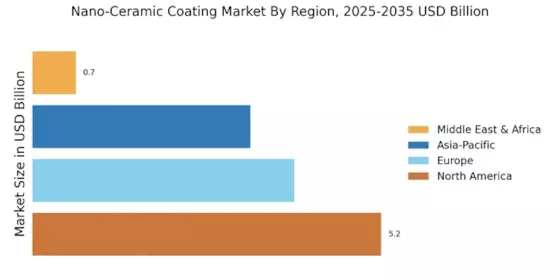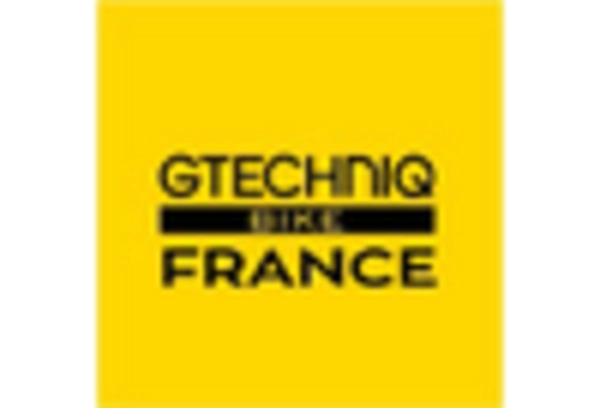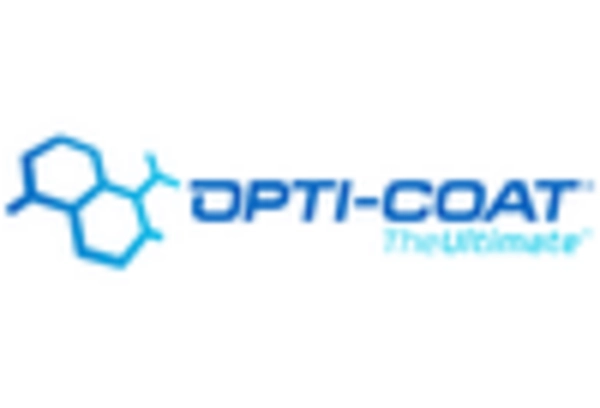Growth of the Construction Sector
The Nano-Ceramic Coating Market is benefiting from the robust growth of the construction sector, which is increasingly utilizing advanced coating technologies for various applications. Nano-ceramic coatings are being employed in residential and commercial buildings to enhance surface protection against weathering, stains, and corrosion. This trend is particularly evident in regions experiencing rapid urbanization and infrastructure development. Industry expert's suggest that the construction segment is expected to witness a significant uptick in demand for nano-ceramic coatings, potentially contributing to a multi-billion dollar market size. As builders and architects seek innovative solutions to improve the durability and aesthetics of structures, the adoption of nano-ceramic coatings is likely to become more prevalent.
Expansion in Industrial Applications
The Nano-Ceramic Coating Market is witnessing an expansion in its applications across various industrial sectors. Industries such as aerospace, electronics, and manufacturing are increasingly adopting nano-ceramic coatings for their protective and functional properties. These coatings enhance surface durability, reduce friction, and provide thermal resistance, making them ideal for high-performance applications. For instance, in the aerospace sector, the use of nano-ceramic coatings can lead to improved fuel efficiency and reduced maintenance costs. Market analysis suggests that the industrial segment is poised for significant growth, potentially reaching a valuation of several billion dollars as more industries recognize the advantages of incorporating advanced coating technologies into their processes.
Rising Demand for Automotive Protection
The Nano-Ceramic Coating Market experiences a notable surge in demand driven by the automotive sector's increasing focus on vehicle protection. As consumers seek to maintain the aesthetic appeal and longevity of their vehicles, the adoption of nano-ceramic coatings has become prevalent. These coatings offer superior resistance to scratches, UV rays, and chemical damage, which is particularly appealing to car enthusiasts and everyday drivers alike. Market data indicates that the automotive segment accounts for a substantial share of the nano-ceramic coating market, with projections suggesting a compound annual growth rate of over 10% in the coming years. This trend reflects a broader consumer awareness regarding vehicle maintenance and the long-term benefits of investing in high-quality protective solutions.
Consumer Preference for Long-Lasting Solutions
The Nano-Ceramic Coating Market is significantly influenced by consumer preferences shifting towards long-lasting and durable solutions. As consumers become more discerning about product longevity, the demand for coatings that offer extended protection against environmental factors is on the rise. Nano-ceramic coatings, known for their exceptional durability and resistance to wear and tear, align well with this consumer trend. Market data indicates that products with enhanced longevity are increasingly favored, with consumers willing to invest in higher-quality solutions that promise better performance over time. This shift in consumer behavior is likely to drive further innovation and development within the nano-ceramic coating market, as manufacturers strive to meet evolving expectations.
Technological Innovations in Coating Formulations
The Nano-Ceramic Coating Market is characterized by ongoing technological innovations that enhance coating formulations and application methods. Advances in nanotechnology are leading to the development of more effective and versatile coatings that cater to diverse industry needs. Innovations such as self-cleaning properties, enhanced adhesion, and improved thermal stability are becoming increasingly common. These advancements not only improve the performance of nano-ceramic coatings but also expand their applicability across various sectors, including automotive, aerospace, and consumer goods. Market trends indicate that companies investing in research and development are likely to gain a competitive edge, as they introduce cutting-edge products that meet the demands of a dynamic marketplace.


















Leave a Comment